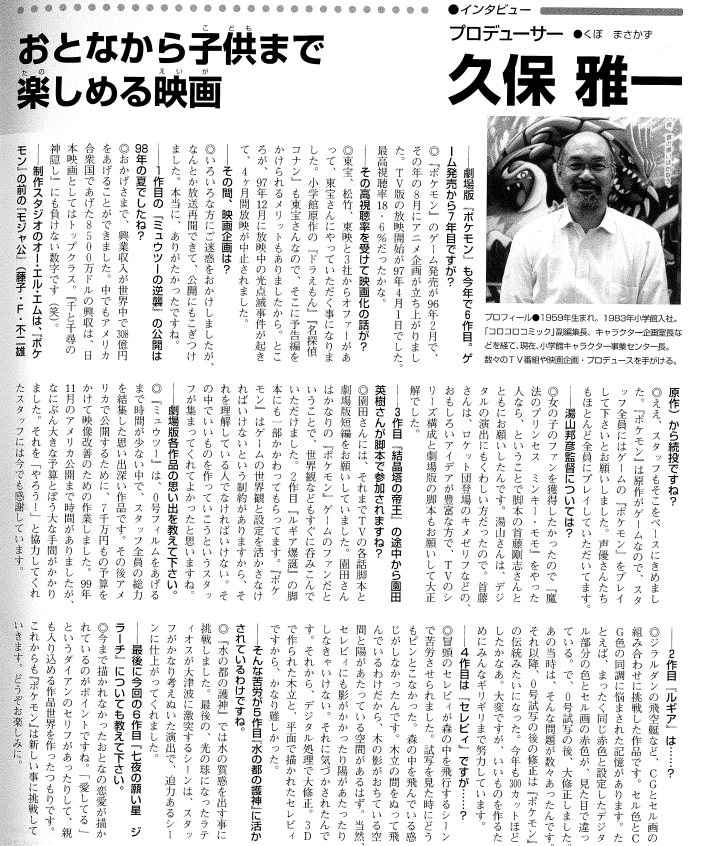

Profile: Born in 1959, he joined Shogakukan in 1983. After serving as deputy editor of "CoroCoro Comic" and head of the Character Planning Office, he is currently head of Shogakukan's Character Business Center. He has planned and produced numerous TV programs and movies.
—This year marks the sixth "Pokemon" movie. Has it been seven years since the game was released?
The "Pokemon" game was released in February 1996, and the animation project was launched in August of the same year. The TV version started airing on April 1, 1997. The highest rating was 18.6%, I think.
—And the high ratings would lead to the offers to make the show into a movie?
We received offers from Toho, Shochiku, and Toei, and we decided to have Toho do it. Toho also produced "Doraemon" and "Detective Conan," both original Shogakukan works, so we had the advantage of being able to put trailers there. However, in December 1997, there was a flashing light incident during the airing of an episode, and the airing was suspended for four months.
—What about the movie project in the meantime?
We ended up inconveniencing a lot of people, but we managed to get it back on the air and release the film. I am truly grateful for that.
—The first film, "Mewtwo Strikes Back," was released in the summer of 1998, wasn't it?
Thanks to everyone's support, it grossed 30.8 billion yen worldwide. Among them, the 85 million dollars it grossed in the United States was one of the highest for a Japanese film. It is a figure that is as high as that of "Spirited Away" (laughs).
—The production studio OLM continued after Mojacko (based on Fujiko F. Fujio's work), which preceded Pokemon, didn't it?
Yes, that was the basis for the staff as well. Since "Pokemon" is based on a game, I asked all the staff to play the game "Pokemon." Almost all of the voice actors have played it.
—What about the director Yuyama Kunihiko?
I wanted to attract female fans, so I asked him and Shudou Takeshi, who wrote the script, because I thought that the people who worked on "Magical Princess Minky Momo" would be a good choice. Yuyama was also familiar with digital staging. Shudou had a lot of interesting ideas, such as the signature phrase for Team Rocket's appearance, and it was a great decision to ask him to write the script for both the TV series and the movie version.
—Sonoda Hideki joined as a scriptwriter in the middle of the work on the third film, "Emperor of the Crystal Tower," didn't he?
Until then, I had asked Sonoda to write the scripts for the TV episodes and movie shorts. Sonoda is a big fan of the "Pokemon" games, so he was able to quickly understand the worldbuilding and other aspects. He was also partially involved in the script for the second film "Revelation Lugia." "Pokemon" is restricted by the need to make use of the game's universe and traits, so the script must be written by someone who understands them. I am glad that we were able to gather a staff that was willing to create something good within that context.
—What are your memories of each film?
"Mewtwo" was a memorable work that required the collective efforts of the entire staff in the short time available before we could get the No. 0 print made. After that, we spent 70 million yen to improve the visuals in order to release it in the U.S. There was still time before the film's release in the U.S. in November 1999, but it required a large budget and a great deal of time and effort. I am still grateful to the staff who agreed to do it.
—What about the second film "Lugia"...?
This film challenged us to combine CG and celluloid images, such as Girardin's airship. I remember that I was troubled by the synchronization of cel colors and CG colors. For example, the color of the digital segment, which was set as exactly the same red, and the red of the cel image were visually different. So, after the No. 0 preview, we made major corrections. There were many such problems at that time. After that, making corrections after the No. 0 preview became like a tradition for "Pokemon." I think we did about 300 cuts this year. It's a lot of work, but everyone is working until the very last minute to make it good.
—And the fourth film "Celebi"...?
We had a hard time with the opening scene of Celebi flying through the forest. When I saw the previews, it didn't feel right. I didn't feel that it was flying through the forest. Since it is flying through the trees, there must be spaces where the shadows of the trees are cast and spaces where the sun shines. Naturally, Celebi had to be in shadow and in the sun. That's what I realized. Then, we made major corrections with digital processing, which was quite difficult because the tree clusters were created in 3D and Celebi was drawn flat.
—So you had applied these hardships to the fifth film, "Guardian Spirits of the Capital of Water."
In "Guardian Spirits of the Capital of Water," we tried to bring out the texture of water. The final scene, in which Latios becomes a ball of light and crashes into the giant tidal wave, was one that the staff gave a lot of thought to and they created a very powerful scene.
—Finally, please tell us about this sixth film, "Jirachi, the Wishing Star of the Seven Nights."
The key point is that it depicts a love story between adults that has never been depicted before. I think we have created a world that even parents can enter, with Diane's line, "I love you." "Pokemon" will continue to challenge new things in the future. Please look forward to it.